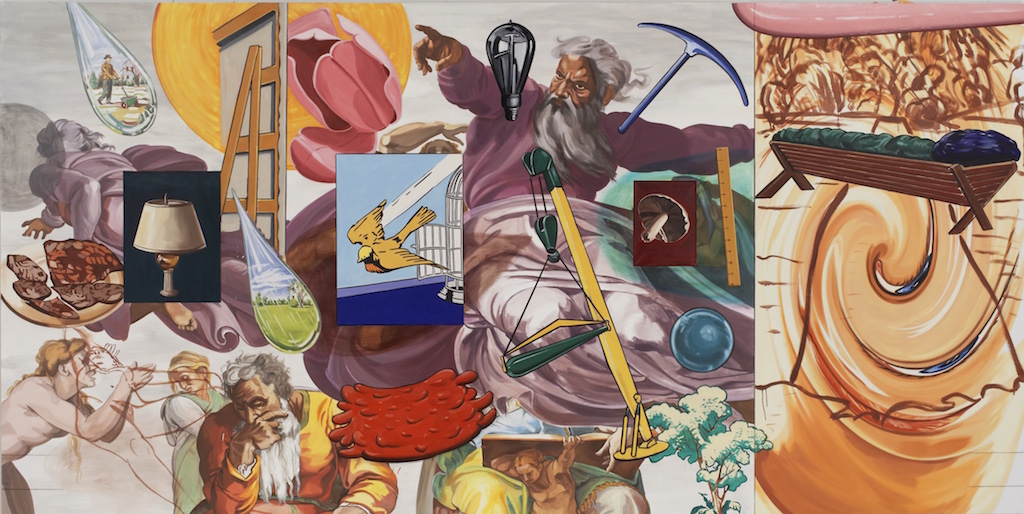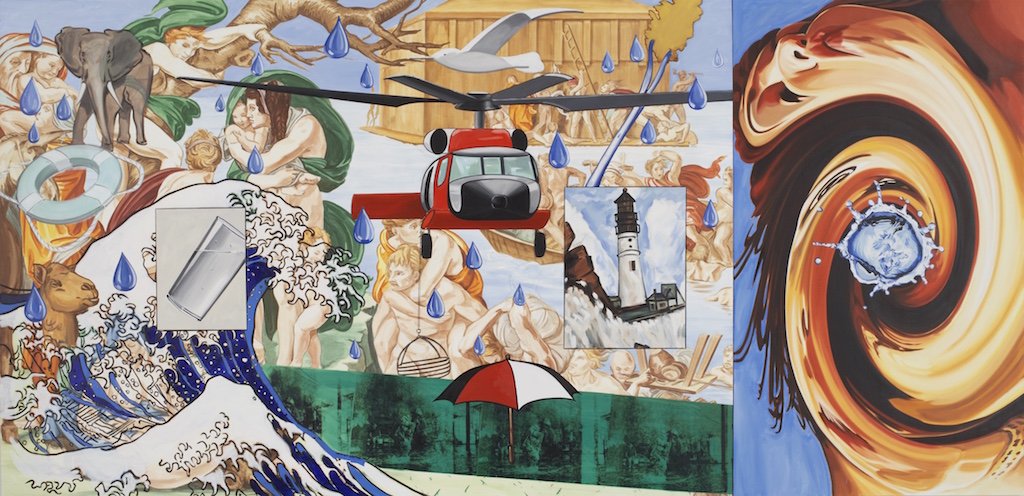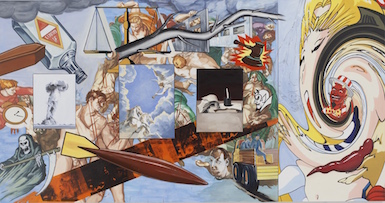[ad_1]

David Salle, After Michelangelo, The Creation, 2005–2006.
©DAVID SALLE/VAGA AT ARTISTS RIGHTS SOCIETY (ARS), NY/PARRISH ART MUSEUM, WATER MILL, NEW YORK, GIFT OF TINA BILOTTI
For three paintings he made more than 20 years ago, David Salle stared down some daunting subject matter: Michelangelo’s masterpiece for the ceiling of the Sistine Chapel.
That was the source of what Salle called the “wacko idea” for a commission presented to him by collector Carlo Bilotti, and it’s all there in three works from 2005–06 that came about as a result: After Michelangelo, The Creation; After Michelangelo, The Flood; and After Michelangelo, The Last Judgment. Never before shown in the United States, they were recently donated to the Parrish Art Museum in Water Mill, New York, where they will soon go on view.
“Who could possibly engage with the Sistine Chapel? It’s the height of hubristic folly,” Salle said of Bilotti’s notion for new paintings to make. “I did it for him—he was such a believer in it as something that could be engaged in a contemporary way. I did it out of his belief.”
Two years before he died, Bilotti—“a loquacious retired Italian-American perfume executive from Palm Beach, Florida,” as he was once described in the International Herald Tribune—enlisted Salle to make the three works to show alongside commissions by two other artists (Damien Hirst and Jenny Saville) in his new Museo Carlo Bilotti in Rome. And there they appeared as part of an inaugural exhibition in 2006 that featured new works interspersed with others from Bilotti’s collection, including canvases by Andy Warhol and Willem de Kooning as well as 22 works by Giorgio de Chirico. “I know the Museum of Modern Art would have taken these 22 wonderful de Chiricos and given me a room, or I suppose I could have given my collection to a museum here in Florida,” Bilotti told the Tribune at the time. “But let’s face it, Boca Raton isn’t Rome!”
Recalling the commission two decades later in his studio in Fort Greene, Brooklyn, Salle said he expressed some trepidation when it was first broached. “I said, ‘Carlo, that doesn’t sound very promising to me.’ He said, ‘Well, I had originally intended it for Andy.’ “
Given that Warhol was dead, Salle took it on. “I said yes because for me it was an opportunity to learn about the Sistine Chapel, which I had seen but hadn’t really thought about much. Saying yes to Carlo was a way of saying, ‘I’ll learn something about the Renaissance.’ ”
He learned about scripture, too. “Not being a student of biblical literature, putting it mildly, I didn’t know the stories or symbology,” Salle said. “I kind of started from scratch. But my interest in it was formal.”

David Salle, After Michelangelo, The Flood, 2005–2006.
©DAVID SALLE/VAGA AT ARTISTS RIGHTS SOCIETY (ARS), NY/PARRISH ART MUSEUM, WATER MILL, NEW YORK, GIFT OF TINA BILOTTI
Into the divine imagery of Michelangelo’s masterwork painted more than 400 years ago Salle incorporated references to contemporary events, such as visions of Hurricane Katrina and the 2004 Indian Ocean tsunami in After Michelangelo, The Flood and modern industrial and mechanical inventions in After Michelangelo, The Creation. “In the way that I work—not in every case, but often—there’s a background, almost like a given,” Salle said. “Sometimes the given is derived from one of my photographs or from something else, a tapestry or some other backdrop, a layer in the painting to which everything else responds. In that sense it wasn’t different from things I’ve made all along.”
The methodology dates back to earlier in his career, he said. “I did so much work for the theater making backdrops, which were always meant to be seen with dancers in front of them—the painted part was the background and the dancers were the foreground. So the Michelangelo parts were the backdrops, and the other parts are the ballet.”

David Salle, After Michelangelo, The Last Judgment, 2005–2006.
©DAVID SALLE/VAGA AT ARTISTS RIGHTS SOCIETY (ARS), NY/PARRISH ART MUSEUM, WATER MILL, NEW YORK, GIFT OF TINA BILOTTI
The context is more freighted than usual, though, given its grounding in the creation of the cosmos and the fragile balance that keeps the universe afloat. “If one is going to engage with it all, it seems to me that everyone has to think about the implications of the story,” Salle said. “I don’t usually talk about subject matter in this way, but maybe now it is warranted. You start thinking about the flood, and it’s not even a jump to start thinking about the world that we live in. You don’t have to think theologically to find it relevant.”
And not just relevant but timely, given the increasingly intense realization that long-looming climate crisis has arrived. “The conditions haven’t changed—peoples’ awareness has changed,” Salle said when asked if the valence of his imagery has shifted since he made the paintings more than a decade ago. “We’ve all known, for a good 20 years, that disaster is just around the corner.”
But hopefully art can serve as a salve, both for the artist and the audience that will get to see his Sistine Chapel paintings on Long Island thanks to their donation to the Parrish by Margaret S. Bilotti, the widow of Carlo (who died in 2006). The works will be included in “Every Picture Tells a Story,” an exhibition of the museum’s permanent collection that opens November 11 and runs for nearly a year.
When asked if his Sistine Chapel paintings hold a special place in his heart when thinking about his oeuvre, Salle struck an even tone. “I don’t think of my work that way,” he said. “It’s all of a piece to me. I made them; I’m making something else now.” But then: “I’m happy to see them again.”
[ad_2]
Source link

